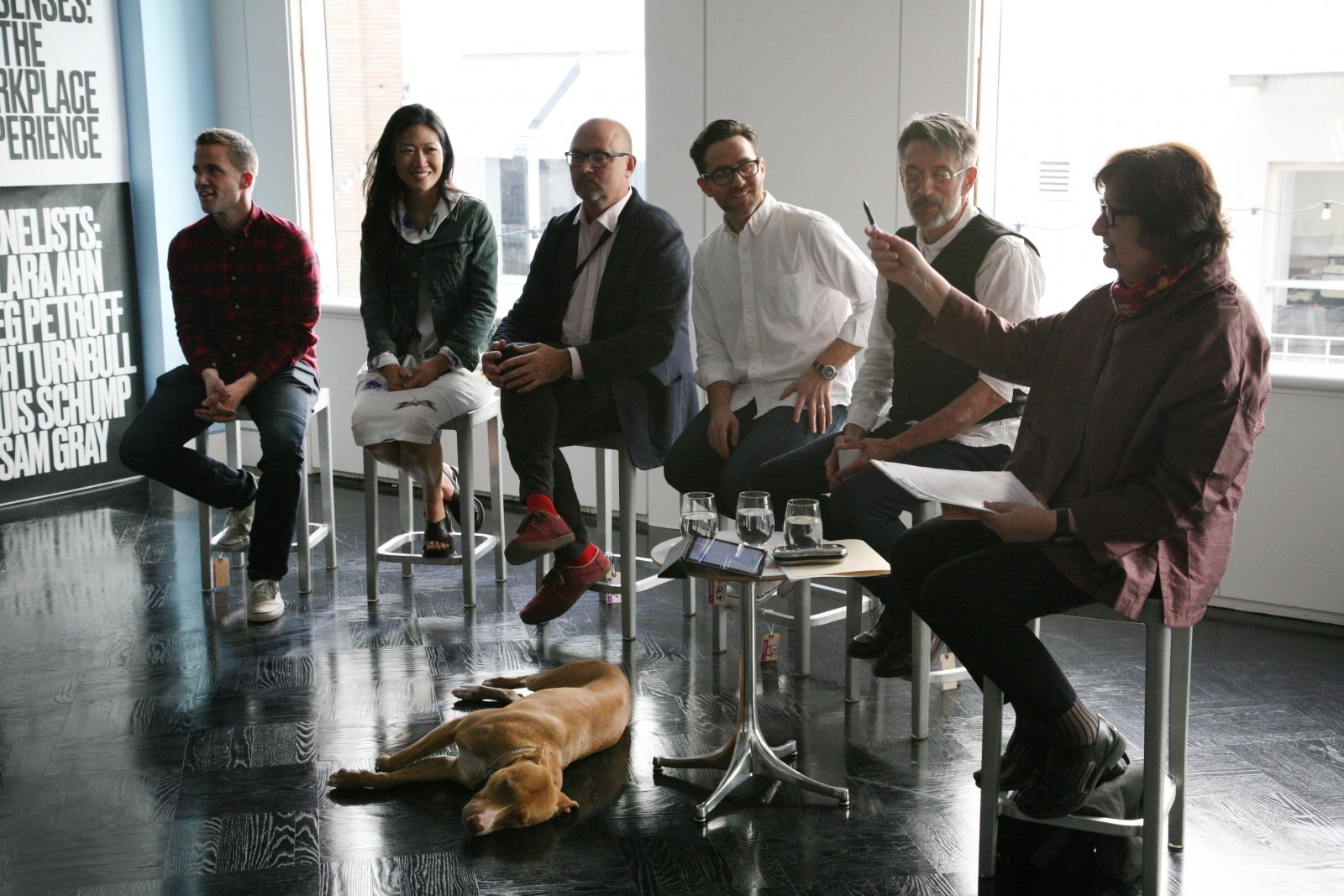
May 13, 2016
What Is the Role of Technology and Sensory Experiences in the Office?
As part of the Metropolis Think Tank series, Susan S. Szenasy talked with Rapt Studio and representatives from Dropbox and GE Digital about the role of technology and sensory experiences in the office.

Susan S. Szenasy speaks with panelists during a Metropolis Think Tank conversation at the Rapt Studio San Francisco offices.
Courtesy Claudia Veizaga
Throughout 2015, Metropolis’s publisher and editor in chief, Susan S. Szenasy, led the Metropolis Think Tank series of conversations on the seismic cultural shifts reshaping our society and the importance of injecting a new humanism into design and architecture in order to better deal with emerging challenges. As part of these ongoing discussions, Szenasy engages key industry leaders and gives a voice to different knowledge groups that participate in these processes—from architecture firms and clients to researchers and consultants.
On February 24, 2016, she talked with Rapt Studio, a global design practice based in San Francisco, and representatives from its top clients, including Lydian Dental, Dropbox, and GE Digital. They discussed the role of technology and sensory experiences in the office, as well as the extensive research and development that goes into creating a more humanistic workplace. What follows is an edited transcript of the conversation.
Personal Empowerment
Susan S. Szenasy, Metropolis: When clients explain their business models and approaches to work, it helps us understand the design response. Let’s start with Lydian Dental.
Joshua Turnbull, founder and CEO, Lydian Dental (JT): We’re out to reinvent an industry that’s stale and lacks innovation. Dentists are terrible businesspeople. We don’t get any business training in school, yet we try to run a business. My research revealed that there isn’t a single industry brand that’s aspirational—there are no midsize companies. So we set out to create an aspirational brand. There are three important parts to our business. We set out to reimagine what it feels like to enter a dental practice. When you think of walking into a dental clinic, you think of horrible sounds and smells. They are also usually cramped and dark. We partnered with Rapt Studio and re-created what it should feel like to walk into a dental clinic.
SSS: I’m curious about the design side. Obviously you did a lot of research as part of the project, but how did you integrate that research and apply it to the project?
Louis Schump, account executive, Rapt Studio (LS): Our first engagement with Josh and his team was to help develop their brand. They had a name but didn’t know what the brand attributes were and how they might manifest themselves in the space.
JT: Before we approached Rapt, I had done a lot of research, looking at the big design and architecture firms. What I loved about Rapt was their approach in identifying what they stand for as a brand—why should people care about you, what are your attributes—and then bringing that into the space and helping it come alive. We had a list of core values that I had thought a lot about. Then we took each of those points and connected them to photos of people, places, and pets. Next we asked, “What do we mean by familial?” and we started to put color around all those attributes. Then, we mapped out the entire experience for every touch point that a patient has with us.
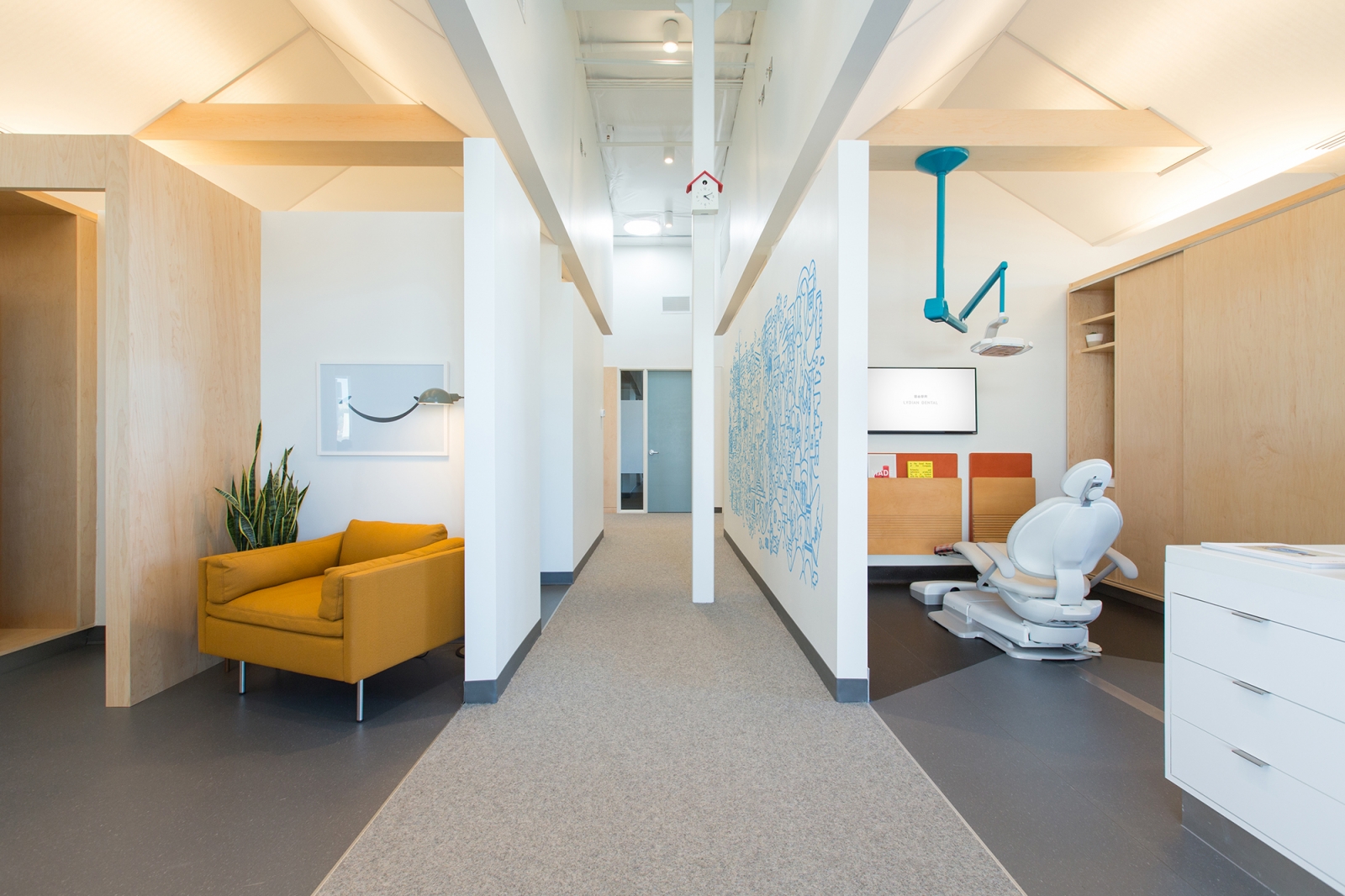
One of the main objectives of the space for Lydian Dental was to feel like you weren’t at the dentist. Taking inspiration from the home, the office features a living room, a small lounge, photo booth, and operatories. The pitched ceiling and Navajo throw blankets add to the residential feel.
With a membership platform that provides all-inclusive dental services to patients for a relatively low annual fee, Lydian Dental is changing the face of dentistry in the United States. The smart design makes for an unexpected dental experience.
Courtesy Weston Colton
Individual Empowerment Supported by Research
SSS: In our digital world, workplace design needs to connect with people, and be more human than ever in modern times. The Dropbox story is a really interesting one, starting from the beginning.
Glara Ahn, experience design lead, Dropbox (GA): The origin story is relevant to the product we ended up with. Dropbox started when our co-founder, Drew, took the Chinatown bus from Boston to New York and realized he forgot his USB. Right then and there he started writing the first lines of code to solve his problem. Fast-forward nine years. Today we have a product that, first and foremost, is about simplifying your life.
Louis’s team and I have set out to build our new headquarters in a way that represents our product and our culture, and make sure that what we end up with isn’t just what any tech company in this era would end up with, but something that’s really, truly Dropbox.
SSS: It’s interesting how you went about finding out what the general consensus would be, and your method of gathering input from a lot of the people who work at Dropbox. To get their buy-in and understand this multisensory world that you were trying to create—what’s your process?
GA: What sounds simple is actually hard to create. What are we working on? Who are we servicing? Our approach to office design is not different from when we build technology. We did months of research with the team. Need-finding is critical, because to build something that’s large, you need a North Star. You need the millions of dollars put in and the hundreds of people working on it to all agree on the goals of the space.
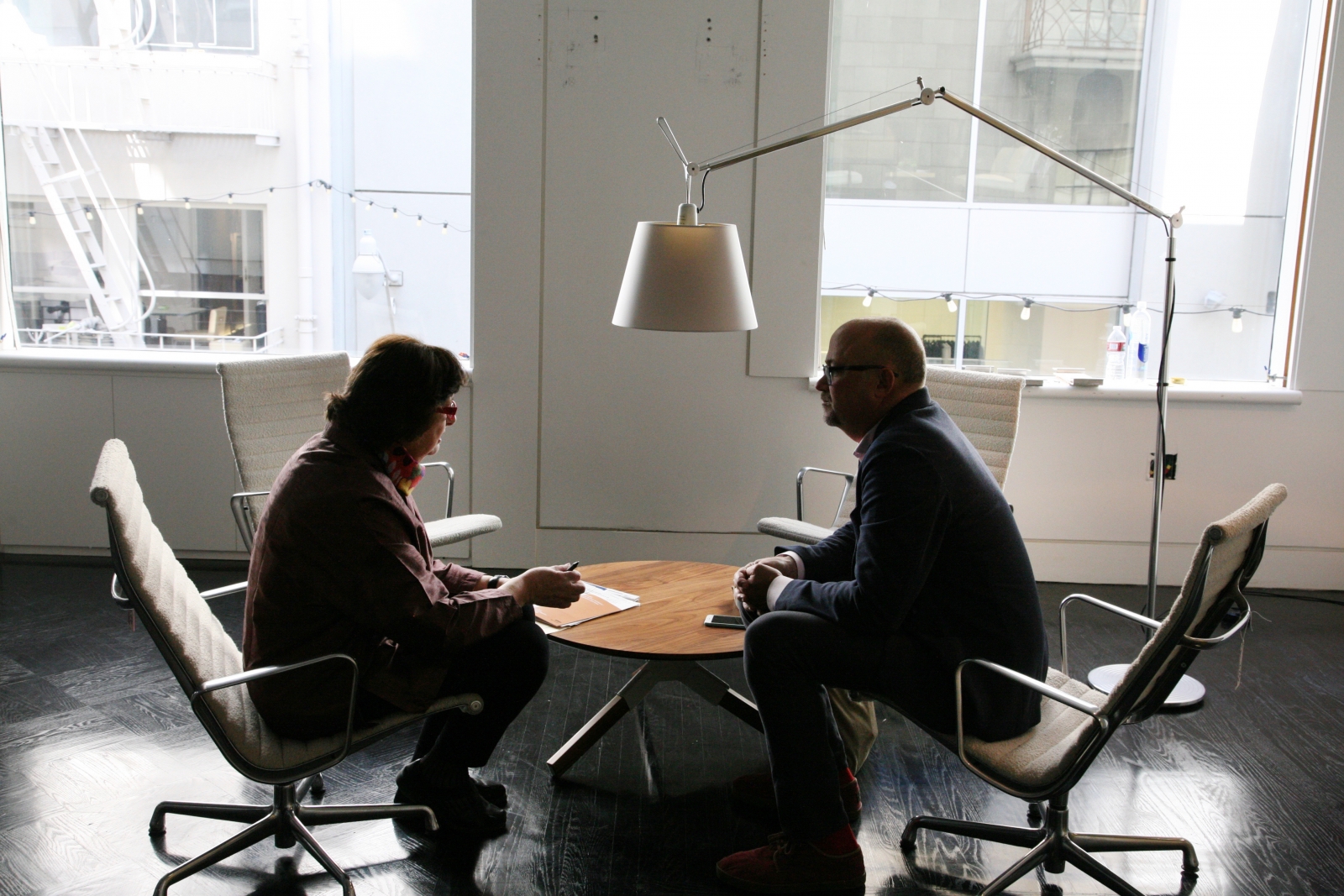
Susan S. Szenasy sits down to speak with Greg Petroff, Chief Experience Officer at GE Digital.
Photography by: Claudia Veizaga
Our research phase included three parts: The first involved the executive team. We interviewed every single one of them in individual and group settings. Then we had a dozen people who each represented their team, but weren’t necessarily leads on that team. We asked them for advice on everything, including with whom we should work. We interviewed Rapt with these teams. We asked them to map out their day-to-day activities, from the minute they enter through the door to the minute they leave. The third group was the entire company. We had four surveys sent out and we analyzed the results.
We took all that research and created a system that everyone could get behind. Each little space in the office has a scorecard, like a report card. The report card consists of what that space would do to you, to your five senses. For example, if it’s a desk area, it can’t smell like food because that’s a distraction. If it’s a gym then it’s going to be loud, so it can’t be next to a library. These scorecards of the five senses were a real consensus driver for the designers who worked on the space because we could be deciding what kind of carpet to put in the library and just look at the scorecard and know what we wanted to achieve. More than anything, it brought the team together to a central ethos that gave a sense of importance to our day-to-day design work. As designers, we believe that every design decision matters—it’s not just about being beautiful, but servicing these really fundamental human needs and functions. It made us focus on the fact that everything we do needs to be functional. Whether it’s invisible or not, it needs to service the human.
SSS: This very detailed understanding of what Dropbox employees are about and how they work, as well as what their sensory needs are, is probably much more detailed than most designers get these days. What was the biggest challenge you got from Glara’s team, especially when it came to making all the senses play into the spaces you were designing?
LS: I don’t say this often, but there are very few clients who allow me to do my job, and Dropbox is one of them. One of the Dropbox founders walked through the space and liked the way it looked “unbuilt.” We said, “That’s fantastic but we have all this data that says people actually need enclosed spaces.” Because we gathered the data together, we all shared that same experience.
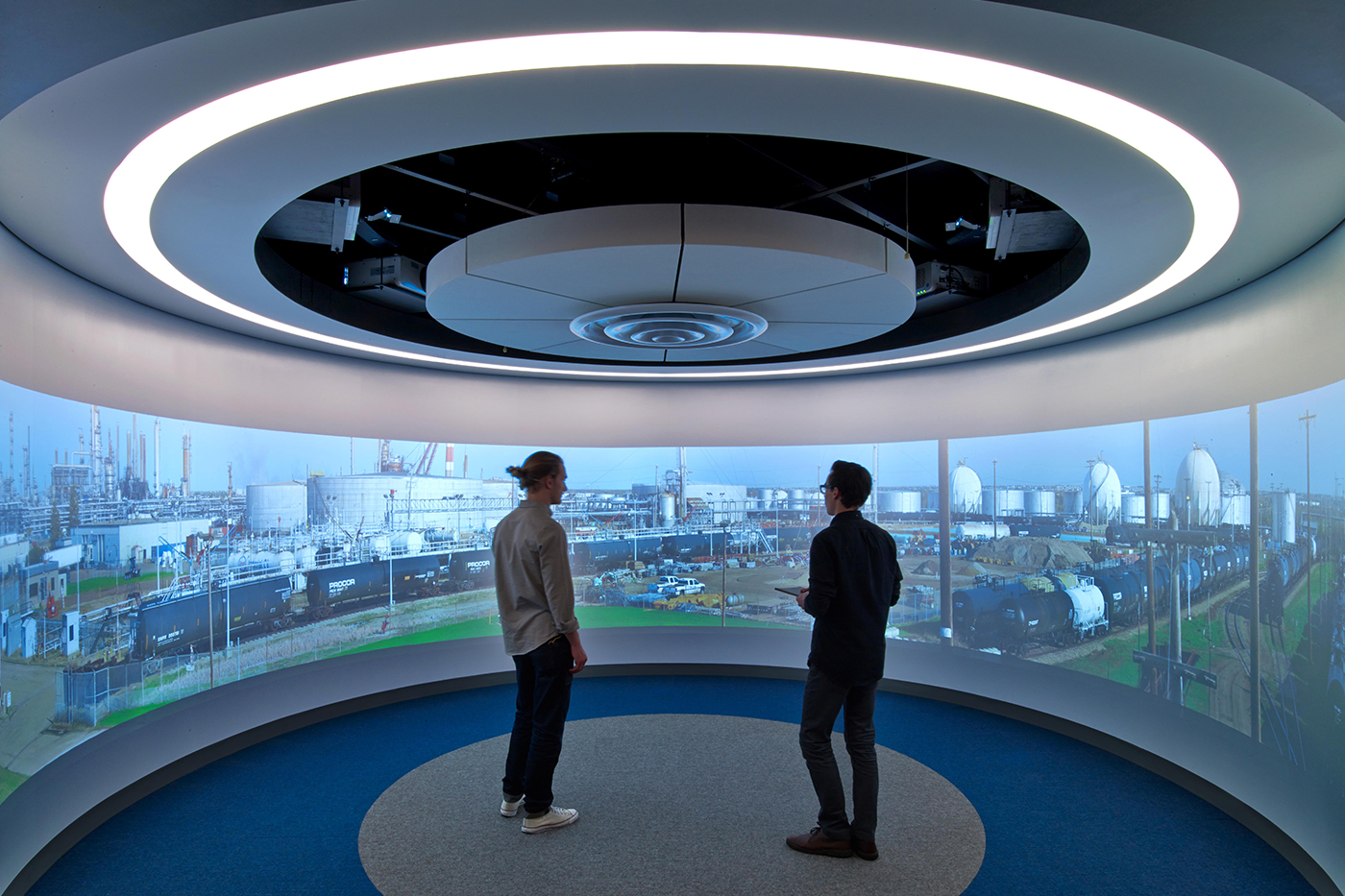
Rapt Studio wanted to be sure to provide GE, one of the worlds largest software companies, with a Design Center that carries the whole scope of their technological capabilities.
Technology and Sensory Experience
SSS: Let’s turn to GE Digital and talk about what happened when you jettisoned GE Capital in favor of the company’s core competency: technology.
Greg Petroff, chief experience officer, GE Digital (GP): If you flew to get here today, the engines on that plane were likely from GE—50% of all planes fly with GE engines. Thirty-five percent of the world’s power is generated on GE generators. About six years ago we did an audit on ourselves and realized that, because we have to build the software to run all these machines, we were also somewhere around the 14th or 15th largest software company in the world and didn’t know it. We are trying to change the culture of the company from one that was very analytics driven, measured, risk adverse, and slow but steady to something that can act on this moment of digitization. We have aspirations to be the Google of machines. To do that we have to attract talent, and we have to create an environment that challenges conventions. Our relationship with Rapt was important because we had a problem: Our existing product managers who had 20 years of experience with building software were using an old technology stack and were working the old way. They had an incrementalist mindset—we’ll add more features, it’ll be one percent faster— but there was a lack of imagination of how to cook with the new ingredients of cloud and platforms. The brief was really hard for Rapt from the beginning because the CEO of GE Digital said, “It has to be like nothing you’ve ever seen before and it has to be awesome.” That was it. That was his criteria for how we developed the project. Rapt recognized that GE has a really strong and healthy culture. As a company it reinvents itself every ten years, and everybody who works there, works on things they think matter for the world. It has this awesome zeitgeist. But sometimes it doesn’t know how to change.
SSS: What makes Rapt’s design such an amazing place to work?
GP: At GE we use similar approaches to Rapt. Journey mapping, for instance—understanding the journey of people coming into the environment. We created a high-pressure environment for co-innovation and unleashing people’s creativity. Then we made deliberate steps on that journey. We walked through all of these processes, a lot of it was developed by us, but it was also developed with the Rapt team. We bounced ideas off each other. Architects and clients are inclined to fill customer innovation centers with technology. In fact, some on our steering committee kept asking for more technology. Rapt constantly challenged us on that by asking, “Why?” “What’s the purpose?” “What are you trying to do?” We de-technologized a lot of the spaces. At the same time, we made sure they still had important technological features.
For instance, we created an amazing digitally immersive space. Oftentimes our user researchers have to go to an oil platform in the North Sea or a railroad yard in Barstow, California. These are dangerous spots, where only one or two people can enter. So we built a GoPro rig that allows us to shoot 360-degree video and created an immersive environment that you can walk into and feel like you’re there. When our user researchers come back, they talk about what they learned, including the culture of the site. We have technology in the space, but it’s all purposely built around the experience we’re trying to drive forward.
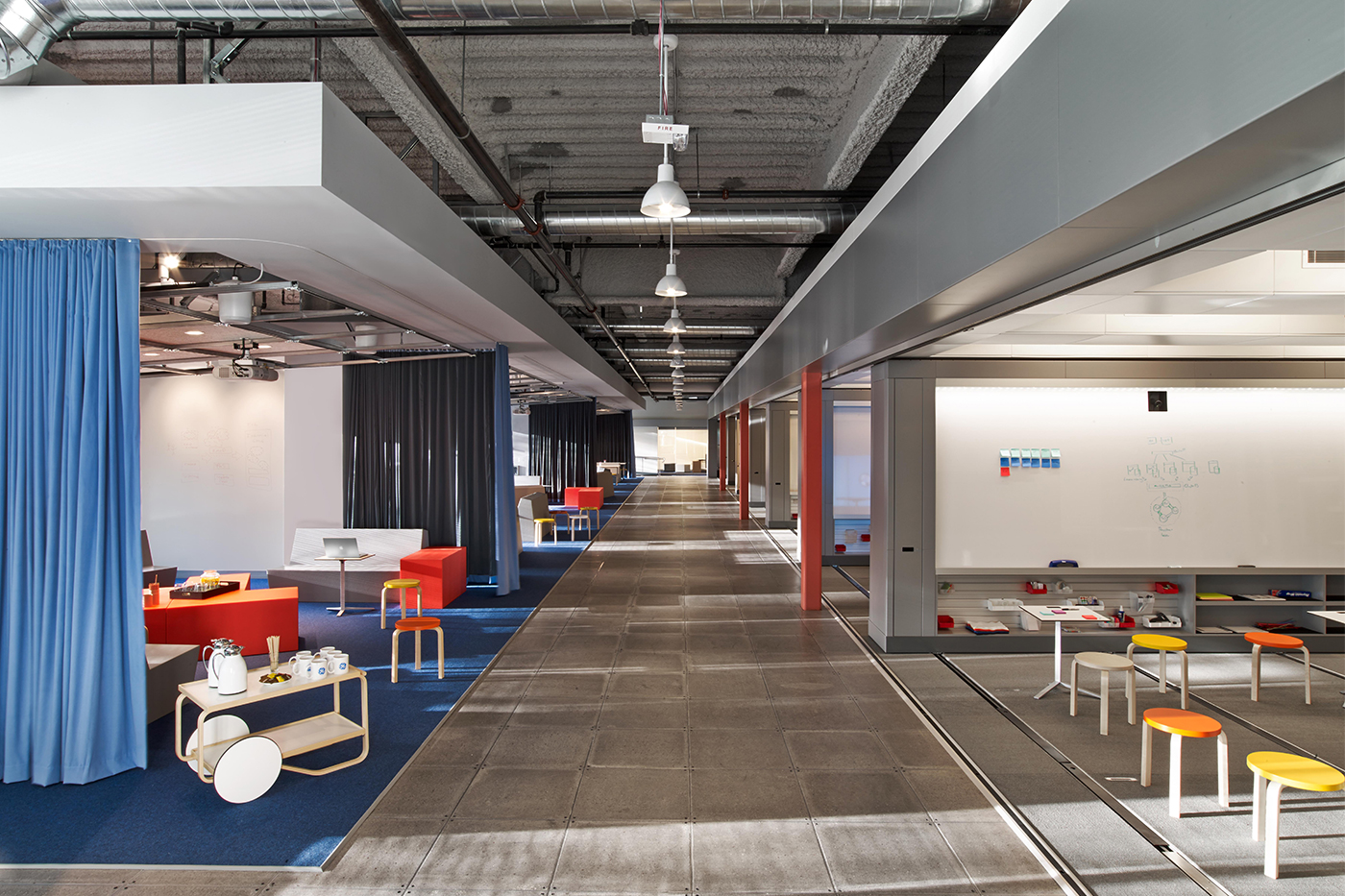
In developing GE’s new space for an agile and inspiring environment for both employees and customers, the new headquarters emphasizes modularity and evolution.
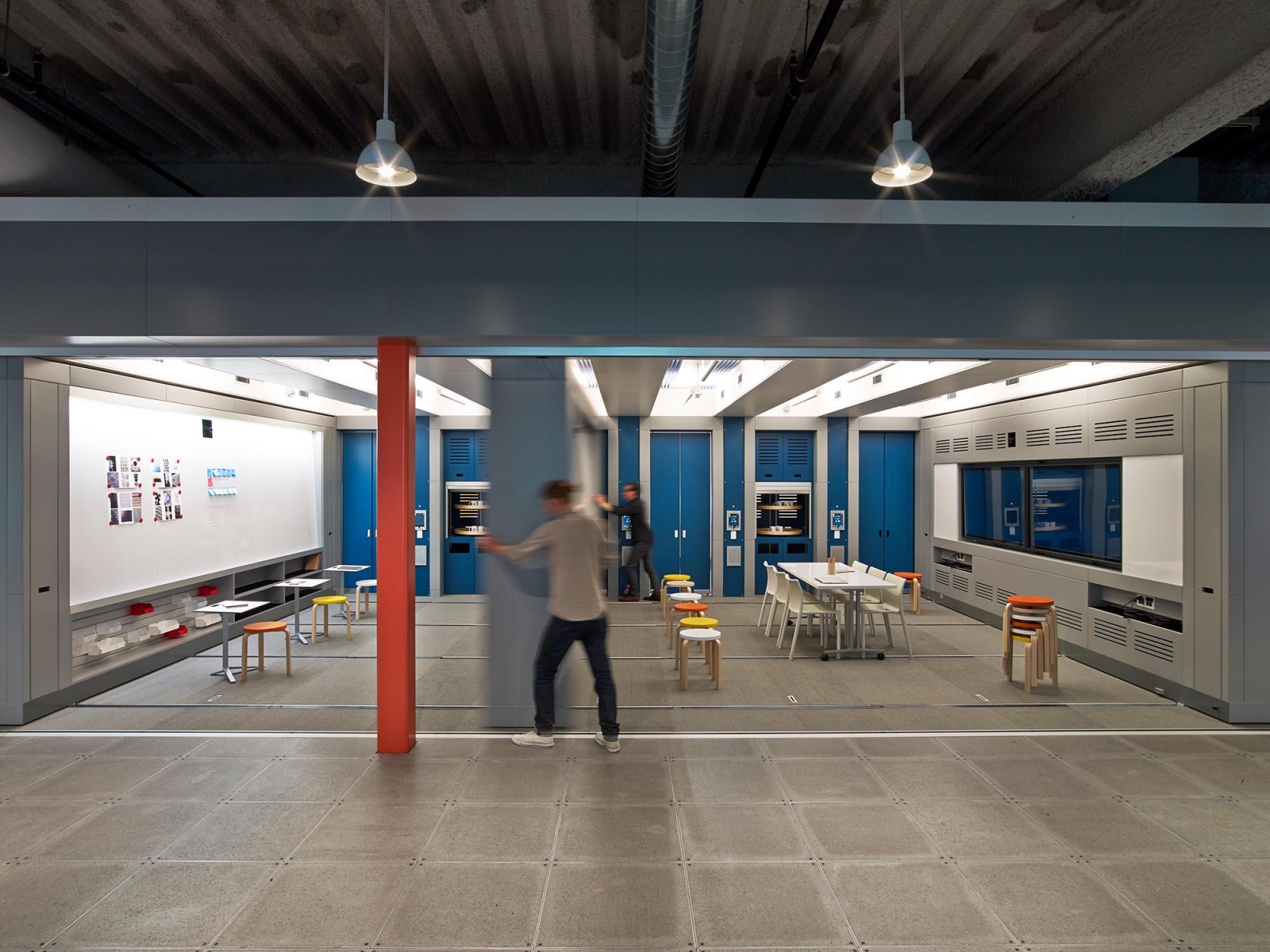
At the heart of the space is the collaboration machine, which can be easily modified as technology evolves.
Courtesy Erick Lagniel
SSS: It’s experiential. It’s not technology for its own sake. This is exactly what’s interesting about these three clients. Are we seeing a drive to make a space as relevant, as important, as humanly supportive, as it possibly can be in a world that’s dominated by technology?
Sam Gray, art director, Rapt Studio (SG): For me, there are two important things to get at in the end: What you do, how you do it, but more importantly, why do you do it. The second question is: What are you trying to do with the information you have? Rather than be prescriptive, we talk about what we want the outcome to be, what we want people to feel, and what our main objective is. It’s important to get clients to think more about what people experience, rather than how they’re going to get there. If we do that first, then we can come together about how we get there, and how we get that job done.
SSS: Clearly your clients have incredibly broad wisdom groups that you can rely on for solid information. Creating great spaces requires collaboration between the designer and the client. For you, the process is actually coworking, isn’t it?
LS: We like to say that our work looks like our clients. It doesn’t look like us. I’m sure there are things that give it away as a Rapt project, but, on the whole, it looks like our clients. Lydian does not look like Dropbox. Dropbox, when it’s finished, will not look like any other technology company, because it will look like Dropbox. The GE machine—no one else has the guts to build a machine like that. It’s a reflection of GE in a way that could never work for someone else.
This Metropolis Think Tank conversation is presented in partnership with our sponsors DuPont Solid Surfaces, Sunbrella, Teknion, ASID, and USG. Think Tank 2016 will be in Washington D.C. next month.
Clients: Dr. Joshua Turnbull, founder and CEO, Lydian Dental; Glara Ahn, experience design lead, Dropbox; and Greg Petroff, chief experience officer, GE Digital
Designers: Louis Schump, account executive, and Sam Gray, art director, Rapt Studio
Moderator: Susan S. Szenasy, publisher and editor in chief, Metropolis






